Agroforestry is taking root in the Democratic People’s Republic of Korea (North Korea). It is regarded as both very important for economic development and for reverting the last 20 years of degradation of natural resources. Agroforestry can effectively mitigate serious soil erosion and prevent flooding that is causing destruction of agricultural land and food shortages in North Korea every year.
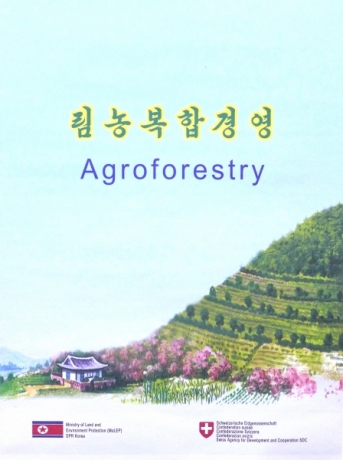
In the last 20 years, North Korea has been subjected to rapid degradation of forests on sloping land because of the high demand for fuel wood, construction timber and the transformation of forest to agricultural land. According to the FAO’s Global Forest Resource Assessment 2010, North Korea’s forest cover has been reduced from 8.2 million hectares (1990) to 5.7 million (2010), this is a reduction in forest land of 127,000 hectares per year over the past two decades. It resulted in floods, landslides, declining soil fertility, loss of infrastructure and crops, power loss and loss of life. Energy continues to be a prominent cause of deforestation in North Korea and, according to the national census of 2008, 77% of rural households dependent on wood and 28 % of urban population use wood for cooking.
To curb this negative trend the Government in North Korea started to support agroforestry development across the country, the first step in this direction was taken by a ground breaking agroforestry project initiated 10 years ago by the Swiss Development Cooperation (SDC) together with Ministry of Land and Environment Protection (MoLEP) in collaboration with ICRAF in China. The project has been scaled up from 4 Sloping Land User Groups (SLUGs) 2005 to 130 SLUGs established by 2013 with 1,200 hectare of established agroforests. Each SLUG has about 10 members and is managing 10 hectare of land. Mrs. Li Sun Ok (pictured below) is one of the SLUG leaders and before she started practicing agroforestry she was working in a textile factory. Today she says that agroforestry has improved her family’s livelihood through the products she gets from the agroforestry farm. About 70 % of what she produces is used by the family and the rest sold on the local market. Other organizations working in North Korea (Concern Worldwide and FAO) have also joined the promotion of agroforestry.
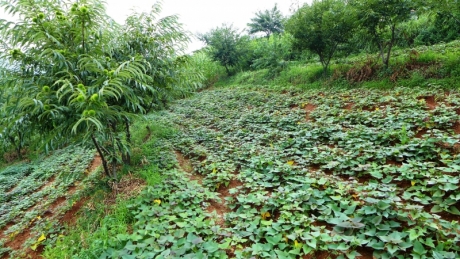 Agroforestry with Chestnut trees and potatoes on contours on sloping land in Suan County. Photo by Bo Lager.
Agroforestry with Chestnut trees and potatoes on contours on sloping land in Suan County. Photo by Bo Lager.
The project has changed the landscape of Suan County in North Hwanghae province and provided a model for agroforestry practices that can be scaled up across the whole country. Today agroforestry is adopted as one of government strategies for economic and sustainable development in the country. The target is to turn 1,500,000 hectare of degraded forests into multipurpose agroforests and more than 1 million households to develop a garden model agroforestry system. In addition 300,000 hectare of erosion prone sloping land should be transformed into a terraced agroforestry landscape. Important success factors of this project has been participatory planning, awareness raising, practical demonstration, exchange visits and good extension services which involves a high degree of collaboration between forest rangers and agricultural extension workers.
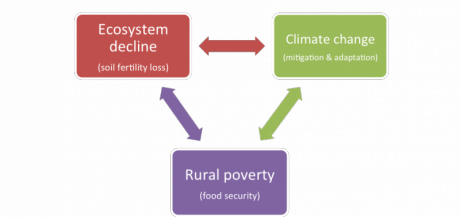 Agroforestry – solution to the triple challenge
Agroforestry – solution to the triple challenge
The value of trees in the agricultural landscape is well documented. Agroforestry provides functions like erosion control, wind shelter, increasing infiltration, mulch, fiber, fodder, food, fuel, medicines, shade, shelter, soil improvement, timber and apiculture. Fruits and nuts provided by trees is very important for supplementing diet in nutritional deficit in North Korea and providing crucial vitamins to the population.
Food shortages in North Korea have become an annual occurrence since the withdrawal of agricultural input support from China, and former Soviet Union at the beginning of the 1990s. North Korea remains in food deficit to this day and in 2014/15 the shortfall was estimated to be 900,000 tonnes, a deficit which has to be supplied via import and/or food aid. The main cause of this large shortfall was the prolonged draught during 2014. Additionally the malnutrition level among the population is very high, 32.4% stunted according to international studies, with a large portion (45.0 %) of the malnourished living in remote and in rural areas. The ambition for the future for North Korea and its international partners should be to move from food aid to food security. Agroforestry in combination with practices like conservation agriculture and multiple cropping can be a solution to the triple challenge of ecosystem decline – climate change – rural poverty and can ultimately improve the food security of North Korea.
A large amount of the sloping land of more than 15 degrees has been transformed from forest to agricultural land but because of continuous cropping, erosion yield has diminished to very low levels (< 2 t/ha). Area of degraded agricultural sloping land is estimated in the area of 300,000-500,000 hectare. This area alone could potentially fill the food gap in North Korea with sustainably produced food.
In North Korea the landscape is very diverse in terms of ecological zones, elevation from sea level up to 2,500 m.a.s.l. with very steep slopes. The main part of the agricultural land is situated in the south western and south eastern parts of the country which is also the most densely populated. About 80% of the land is mountainous and less populated. Agroforestry could be practiced throughout North Korea and is equally important in the agricultural landscape under the jurisdiction of the Ministry of Agriculture as in the forestry landscape under the jurisdiction of MoLEP. Trees provide important ecosystem functions, and in combination with conservation agriculture (CA) there are even more synergies. At landscape levels agroforestry is a proven practice to reduce soil erosion during monsoon. Research trials established by the Agricultural Academy of Sciences (AAS) in the Irish Aid conservation agriculture project, demonstrated that conservation agriculture can reduce erosion from 60 ton/ha to less than 10 ton/ha and at the same time increase yield, reduce labor requirement, reduce the use of fossil fuel, suppress weeds and increase soil moisture. Agroforestry and conservation agriculture have important positive climate change mitigation and adaptation effects.
It’s important to stress the positive impact agroforestry intervention has on Disaster Risk Reduction (DRR) in North Korea. Introducing agroforestry to the watersheds and catchment areas can effectively form an erosion barrier in flood prone and lower catchment areas and prevent large agricultural land to be destroyed.
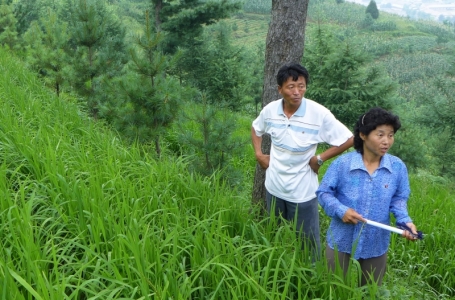 Mrs. Li Sun Ok, SLUG Leader on her farm in Suan County. Photo by Bo Lager.
Mrs. Li Sun Ok, SLUG Leader on her farm in Suan County. Photo by Bo Lager.
User groups and land rights
All land is owned by the state in North Korea and is divided upon clear lines. The Ministry of Agriculture is in charge of agricultural land with less sloping degree than 15 ̊ and manages over 4,000 cooperative farms. The forest land is controlled by the Ministry of Land and Environment Protection (MoLEP) including land over 15 ̊ degrees gradient. But like one of the cooperative farm managers once told me, “we don’t recognize this definition and for me agricultural land is all land where the oxen can access”.
The 4th National Workshop on Agroforestry 2013 presented a deep consensus on the crucial importance of devolution of power towards communities’ and giving them usufruct rights over the products from their farms. The fact that the farmers are selling part of the produce on the local farmers market shows the importance of market and business development in North Korea. The farmer groups have signed an agreement with the County Forest Management Board that gives them rights to the land and the produce for 10 years with possibilities of extending the contract. This has proved very successful in the SDC Agroforestry project whereby existing farmer groups have been introduced to the agroforestry concept through training and international exchange visits to agroforestry projects. The goal is to replicate this model to other parts of the country in the next couple of years. The concept of user groups is not new to DPRK but goes back to the 1960s.
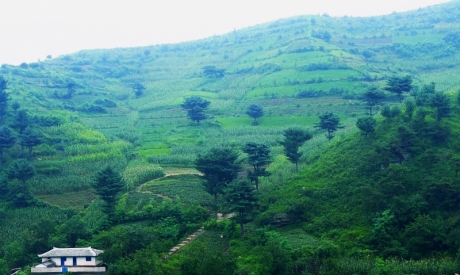 Agroforestry transformed landscape in the SDC project areas in Suan County. Photo by Bo Lager.
Agroforestry transformed landscape in the SDC project areas in Suan County. Photo by Bo Lager.
Future
To achieve long-term food security in DPRK, investment in the agricultural sector has to increase and the system of cooperative farms needs reforms, this means introducing/increasing market oriented mechanisms and an effective incentive system in the agricultural sector. A new policy should go beyond self-sufficiency in agricultural commodities. In addition to this, support to appropriate changes in government agricultural policies (including openness and transparency) and farm strategies is necessary. Agroforestry can play an important part in instigate these changes and improve food security situation in DPRK in the future through increasing production on marginal and sloping lands through protecting the environment and increase the sustainability of agricultural system. The government is paying keen attention to development of the system of user groups and usufruct rights which suggest fundamental changes in the present planning economy therefore these initiatives have the potential of changing the way the government are looking on private ownership and entrepreneurship in the future.
Bo Lager worked as the Programme Manager for Concern Worldwide in Democratic People’s Republic of Korea (DPRK). Prior to this Bo was the Programme Director for Vi Agroforestry programme (Kenya, Tanzania, Rwanda, Malawi and Uganda) between 2006 and 2012. During his time in Vi Agroforestry among other things he was promoting carbon finance in agriculture and agroforestry systems.